Windows Azure Toolkit for Windows Phone 7 Review
Hi, Habrachiteli!

I have been engaged in mobile and embedded technologies for a long time. Restrictions on resources, both of the device itself and its manufacturer, may impose certain restrictions on the services available to the end user of the mobile device. For example, the device is not very powerful; There is no possibility to maintain a dedicated services infrastructure for your device from the manufacturer.
')
When I first learned about cloud technologies, I thought it would be great to get access to the power of the cloud on a mobile device. Since I specialize in Microsoft technologies, I planned to make an example where Windows Azure storage services will be conveniently accessible from Windows Phone 7.
But they beat me.
Windows Azure Toolkit for Windows Phone 7 has been released , a review of which I present to your attention.
Cloud technologies are becoming increasingly popular, the number of smartphone users is growing rapidly. More and more projects combine the client part on a mobile device and the response part in the cloud.
Microsoft did not stand aside. We have a Windows Azure PaaS cloud and a popular Windows Phone 7 mobile platform. From the very beginning of the advent of the Windows Azure cloud platform, it supports the REST API, so you can always write an application that will interact with Windows Azure using regular HTTP requests. But this is far from the convenience of using Windows Azure when developing for a Windows platform.
Windows Azure Toolkit for Windows Phone 7 is designed to simplify the use of the capabilities of Windows Azure technologies on the Windows Phone 7 platform. The set includes class libraries for Windows Phone 7 for interacting with Windows Azure with source code, project templates, sample applications and documentation . It also contains an auxiliary set of services that provide a more secure use of Windows Azure services on a mobile device.
Tulkit is delivered as a self-extracting archive WAZToolkitForWP7.Setup.exe. It is unpacked into the following directory hierarchy:
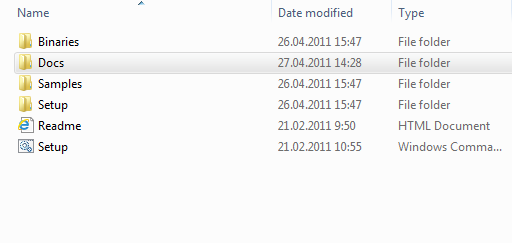
To start the installation of templates, you must run the Setup.cmd file. There will be a utility that checks that the developer’s machine has everything necessary for the workflow of the toolkit.
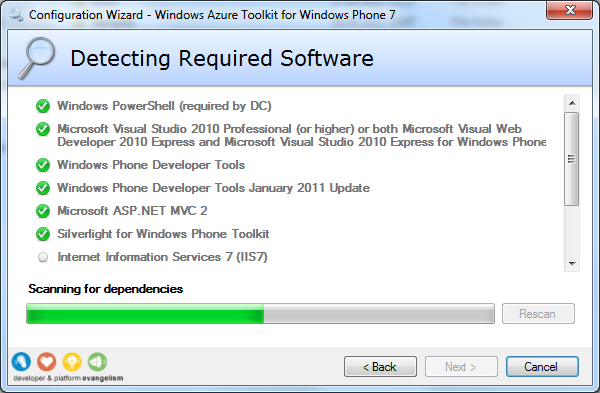
If something is not present, it will give a link to download or to a script that performs the necessary settings. The final installation step is the installation of templates for Visual Studio 2010.
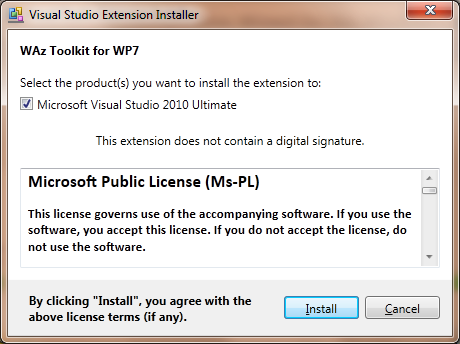
In order to access your storage account on Azure, you need to know the account name and key. Since it is not very safe and convenient to store such information in a mobile application, the toolkit provides services that allow you to use a different authentication model in an application with additional capabilities for delimiting the level of access to data.
The services provided by the toolkit, as well as the website of the user administration system, are hosted in the ASP.NET MVC 2 web role.
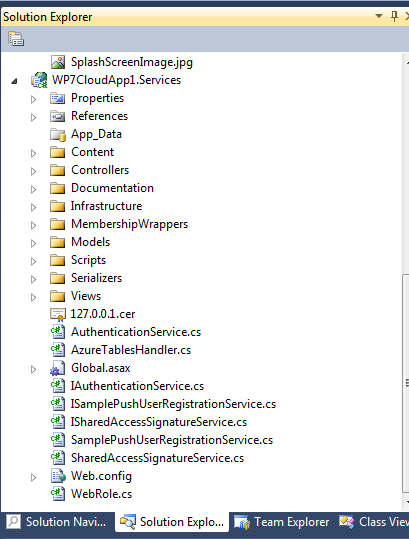
The tulkit authentication services (AuthenticationService) are based on ASP.NET providers (Membership, Roles, Profile and Session State Store) for Windows Azure Tables. The source code of the provider is contained in the toolkit itself (\ Samples \ Libraries \ AspProviders \). Before you can access any data, you must authenticate using this service.
The HTTP REST API handler for requests to Windows Azure tables (AzureTablesProxy.axd) is used as a proxy for requests to Windows Azure tables. The requests that come to this service are signed by the storage account key and redirected to the real endpoint of the Windows Azure tables.
WCF REST service of generating signatures for sharing (SharedAccessSignatureService) for working with containers and BLOBs.
The \ Samples \ Libraries \ folder contains the libraries in the source code:
Tulkit contains two templates, each of which is available in both C # and Visual Basic.
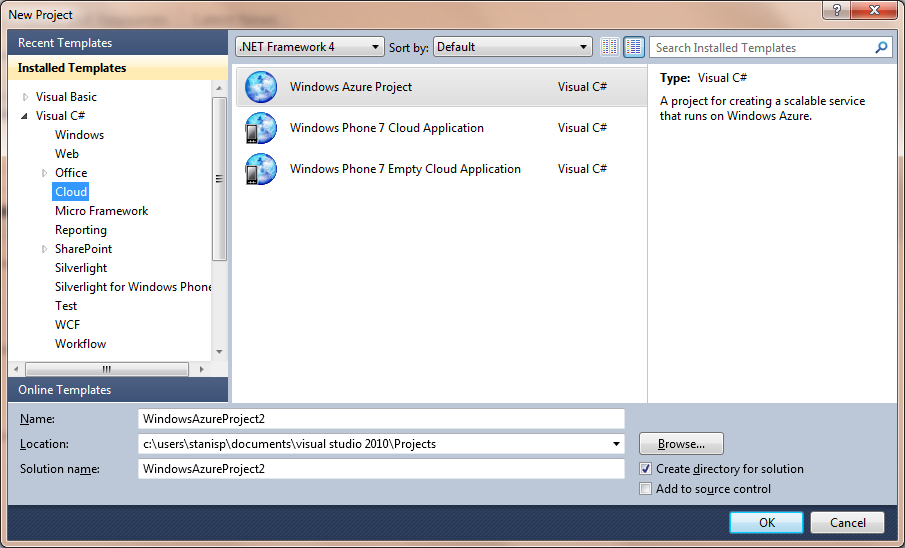
Announcement: http://www.wadewegner.com/2011/03/windows-azure-toolkit-for-windows-phone-7/
Download: http://watoolkitwp7.codeplex.com/
Video from Channel 9: http://channel9.msdn.com/Shows/Cloud+Cover/Cloud-Cover-Episode-41-Windows-Azure-Toolkit-for-Windows-Phone-7
Shared Access Signatures: http://msdn.microsoft.com/library/ee395415.aspx
Auxiliary server library for push notifications (Push Notification Server Side Helper Library) http://create.msdn.com/en-US/education/catalog/article/pnhelp-wp7

I have been engaged in mobile and embedded technologies for a long time. Restrictions on resources, both of the device itself and its manufacturer, may impose certain restrictions on the services available to the end user of the mobile device. For example, the device is not very powerful; There is no possibility to maintain a dedicated services infrastructure for your device from the manufacturer.
')
When I first learned about cloud technologies, I thought it would be great to get access to the power of the cloud on a mobile device. Since I specialize in Microsoft technologies, I planned to make an example where Windows Azure storage services will be conveniently accessible from Windows Phone 7.
But they beat me.
Windows Azure Toolkit for Windows Phone 7 has been released , a review of which I present to your attention.
Cloud technologies are becoming increasingly popular, the number of smartphone users is growing rapidly. More and more projects combine the client part on a mobile device and the response part in the cloud.
Microsoft did not stand aside. We have a Windows Azure PaaS cloud and a popular Windows Phone 7 mobile platform. From the very beginning of the advent of the Windows Azure cloud platform, it supports the REST API, so you can always write an application that will interact with Windows Azure using regular HTTP requests. But this is far from the convenience of using Windows Azure when developing for a Windows platform.
Windows Azure Toolkit for Windows Phone 7 is designed to simplify the use of the capabilities of Windows Azure technologies on the Windows Phone 7 platform. The set includes class libraries for Windows Phone 7 for interacting with Windows Azure with source code, project templates, sample applications and documentation . It also contains an auxiliary set of services that provide a more secure use of Windows Azure services on a mobile device.
Installation
Tulkit is delivered as a self-extracting archive WAZToolkitForWP7.Setup.exe. It is unpacked into the following directory hierarchy:

To start the installation of templates, you must run the Setup.cmd file. There will be a utility that checks that the developer’s machine has everything necessary for the workflow of the toolkit.

If something is not present, it will give a link to download or to a script that performs the necessary settings. The final installation step is the installation of templates for Visual Studio 2010.

Services
In order to access your storage account on Azure, you need to know the account name and key. Since it is not very safe and convenient to store such information in a mobile application, the toolkit provides services that allow you to use a different authentication model in an application with additional capabilities for delimiting the level of access to data.
The services provided by the toolkit, as well as the website of the user administration system, are hosted in the ASP.NET MVC 2 web role.

The tulkit authentication services (AuthenticationService) are based on ASP.NET providers (Membership, Roles, Profile and Session State Store) for Windows Azure Tables. The source code of the provider is contained in the toolkit itself (\ Samples \ Libraries \ AspProviders \). Before you can access any data, you must authenticate using this service.
The HTTP REST API handler for requests to Windows Azure tables (AzureTablesProxy.axd) is used as a proxy for requests to Windows Azure tables. The requests that come to this service are signed by the storage account key and redirected to the real endpoint of the Windows Azure tables.
WCF REST service of generating signatures for sharing (SharedAccessSignatureService) for working with containers and BLOBs.
Libraries
The \ Samples \ Libraries \ folder contains the libraries in the source code:
- AspProviders : ASP.NET providers (Membership, Roles, Profile and Session State Store) on top of Windows Azure Tables;
- System.Data.Services.Client : the version of the OData client library for Windows Phone 7 ( http://odata.codeplex.com ) is amended to support the work with the Azure Table API;
- WindowsPhone.Recipes.Push.Messasges : Push Notification Server Side Helper Library, - server library, part of the “recipe” of “Windows Phone 7 Push Recipe”. Allows you to send all types of push alerts: Tile, Toast, and Raw;
- WindowsPhoneCloud.StorageClient : client library for working with Azure Storage for Windows Phone 7. This library allows you to:
- Create and delete Azure Tables
- CRUD operations on Azure Tables table rows
- Upload BLOBs to public / private containers using Shared Access Signatures;
- Get a list of BLOBs in private / public containers using shared access signatures (Shared Access Signatures)
Visual Studio 2010 Templates
Tulkit contains two templates, each of which is available in both C # and Visual Basic.

- Windows Phone 7 Cloud Application : Simplifies the creation of a Windows Phone 7 application using Windows Azure capabilities. The template generates a Windows Azure project, an ASP.NET MVC 2 project (web role), and a Windows Phone 7 application project. This project demonstrates how you can use Windows Azure storage services without having to store account data on a mobile device.
- Windows Phone 7 Empty Cloud Application : The same as the Windows Phone 7 Cloud Application pattern, but instead of the Windows Phone 7 sample application that demonstrates the capabilities of the toolkit services, an empty Windows Phone 7 project is created with a minimum set of settings and dependencies.
Additionally
Announcement: http://www.wadewegner.com/2011/03/windows-azure-toolkit-for-windows-phone-7/
Download: http://watoolkitwp7.codeplex.com/
Video from Channel 9: http://channel9.msdn.com/Shows/Cloud+Cover/Cloud-Cover-Episode-41-Windows-Azure-Toolkit-for-Windows-Phone-7
Shared Access Signatures: http://msdn.microsoft.com/library/ee395415.aspx
Auxiliary server library for push notifications (Push Notification Server Side Helper Library) http://create.msdn.com/en-US/education/catalog/article/pnhelp-wp7
Source: https://habr.com/ru/post/118569/
All Articles